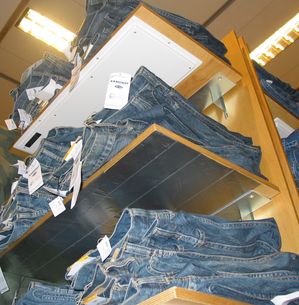RFID Systems provider ADT says it has developed a means of RFID-enabling store shelves in a manner designed to lower infrastructure costs related to tracking products at the item level, while also enabling retailers to add merchandising functionality to product displays. It calls the system iREAD and it consists of networked antennas integrated in shelving and managed by ADT software. The iREAD antennas can be used with any standard EPC Gen 2 reader. German retailer Karstadt has installed the platform as part of its RFID pilot test that began in late summer and focuses on examining ways to use RFID to improve internal business operations (see Karstadt Readies for RFID).
For its pilot, Karstadt is using RFID in three separate processes: tracking goods from the time of arrival at a store until the point of sale; performing and managing inventory; and locating goods to facilitate price changes. It has installed iREAD antennas to the shelving of four garment product displays within the Karstadt RFID test store in Germany, says David Berglund, European RFID business development manager with Tyco International, of which ADT is a business division, and is using them to take inventory in real-time of products displayed on the shelves. In other parts of the store, associates are using handheld mobile RFID interrogators to perform periodic inventory and locate products needed to be marked down.

John Smith, vice president of retail sales for ADT Europe, Middle East and Africa, The key differentiators between the iREAD system and other, similar networked antennas integrated into “smart” shelving systems is that iREAD creates more read zones with fewer interrogators, and that it uses a single cable to power the antennas, interrogate tags and receive their backscatter RF signals. Smith says the iREAD cables can also be used to send text or other alerts to display screens, lights or other communication devices attached to an iREAD smart shelf. For example, he says, a retailer could use a handheld reader to query an iREAD display regarding a specific size of jeans. In response, the software would determine which antennas are reading the EPCs of products in that specific size and then send a command, through the antenna cable, to light an LED at the appropriate shelf locations. (Karstadt is not testing such an application of the iREAD system at this time, however.)
The iREAD system uses strategically placed sheets of foil on shelves in order to block RF signals emitting from certain antennas, thereby creating defined read zones to ensure the iREAD software collects an accurate read count for each shelf.
ADT claims that deploying iREAD to read tags on items and perform inventory will cost a retailer significantly less than outfitting store shelves with enough non-networked antennas and readers. In a typical midsize retail store, it says, an item-level RFID system would require around 100 readers to be installed, at a cost of roughly €300,000 ($435,000). The iREAD system could create just as many read zones as the 100 readers would, but would require an investment of just 10 readers. Smith says that with the iREAD system, the price per read zone comes to about €100 ($146).
In 2006, RFID Journal reported that ADT Europe had developed a system for combined RFID with an electronic article surveillance (EAS) system (see RFID New Roundup: ADT Europe Develops RFID-EAS System). But the iREAD system is not designed to function as a theft-prevention tool and cannot detect EAS, says Berglund, adding that while Karstadt uses ADT’s EAS system, the retailer is interested in combining its RFID and EAS efforts at this time. “Our EAS tags are on the goods involved in the pilot, he says, but so are RFID tags, and the iREAD system is not reading the EAS tags.”
Smith and Berglund say that iREAD is available for use both in Europe and the United States today.

